FREIGELD SERIE / LABOUR CERTIFICATES:
Dies ist eine Cachereihe zum Thema Freigeld in Wörgl. Das Freigeld wurde zur Zeit der Weltwirtschaftskrise in den 1930er Jahren verwendet. Durch dieses Zahlungsmittel schaffte es Wörgl, die Wirtschaft wieder anzukurbeln.
This is a cache-series that shows you a hiking trail around Wörgl where you’ll learn more about the labour certificates. The town used these certificates instead of money in the time of the Great depression in the 1930s. Because of this Wörgl was able to increase its economy at this time.
Dies ist die 3. Station der Freigeldserie. / This is the 3rd cache of this series.
weitere Caches der Freigeldserie: / other caches of this series:
Freigeld Wörgl - Heimatmuseum & Denkmal
Freigeld Wörgl - Aubachschlucht & Sprungschanze
Freigeld Wörgl - Waldfriedhof, Stumpf- & Seislstr.
Freigeld Wörgl - Bonus
Müllnertalbrücke:

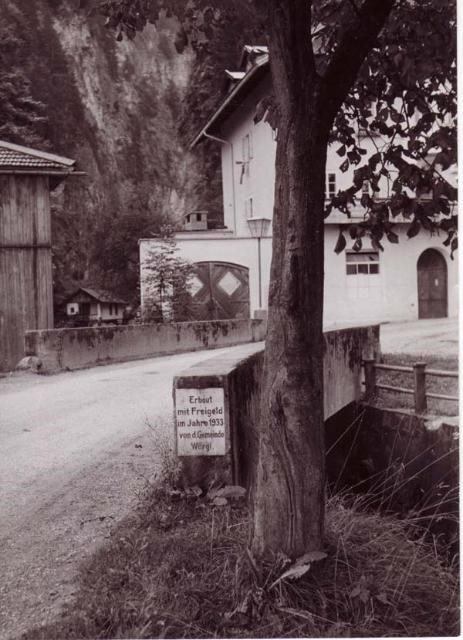
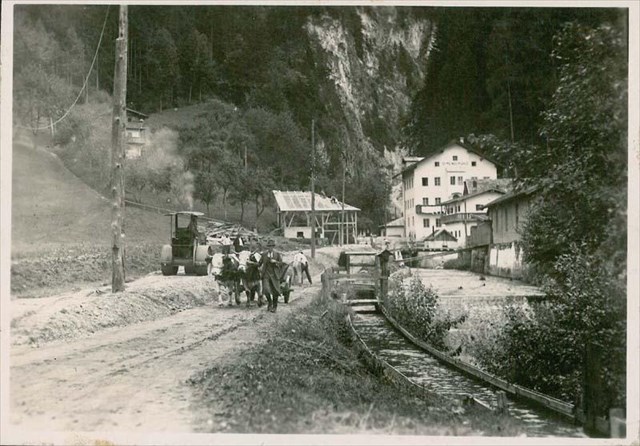
"Erbaut mit Freigeld 1933" - die Marmortafel, die heute im Wörgler Heimatmuseum zu sehen ist, verkündet, dass die Brücke für die Landesstraße in die Wildschönau mit Hilfe von Freigeld finanziert und gebaut wurde. Im Zuge der Brückenverbreiterung in den 1980er Jahren entfernte man die Inschrift.
Die Notstandsarbeiten umfassten unter anderem auch die Einrichtung einer Notstandsküche zur Armenausspeisung und den Bau eines Wasch- und Holzhaus bei der Gemeindemühle, das heute nicht mehr steht. Die Gemeindemühle mahlt auch kein Korn mehr, sondern liefert als Elektrizitätswerk im Eigentum der Stadtwerke Wörgl wertvolle Energie aus Wasserkraft.
This bridge was built in 1933 not with the help of money but with the labour certificates of Wörgl. The marble plaque that reminded us of this event is now located at the History Museum of Wörgl, because in 1980 the bridge was made wider due to the increase of traffic to the Wildschönau. (Picture 1 & 2)
There were also other building projects realized in time of the Great Depression in the 1930s. (Picture 3) Today the mill isn’t a mill any more, but a power station.
KRAFTWERKSRUNDE KW MÜLLNERTAL / POWER STATION MÜLLNERTAL:
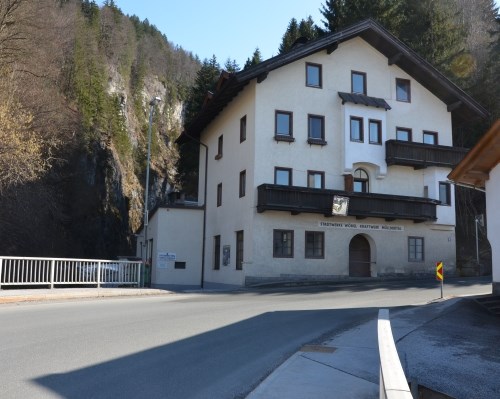
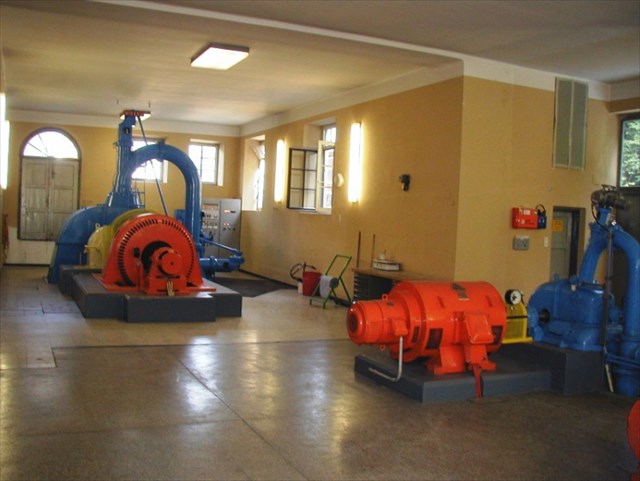
Das ehemalige Laufkraftwerk Müllnertal wurde nach dem 2. Weltkrieg im Jahr 1957 durch den Bau einer Bogensperre im Müllnertal knapp vor der Grenze zur Wildschönau in ein Speicherkraftwerk umgebaut. Der Tagesspeicher wird leistungs- bzw. wasserstandsgeregelt abgearbeitet. Alle 3 Maschinensätze verfügen über je eine Peltonturbine mit angekuppeltem Synchrongenerator. Die gesamte Kraftwerksanlage ist ferngesteuert.
Kraftwerksleistung: 900 kW
Jährliche Stromerzeugung: 2.500.000 kWh entspricht ca. 2.800 Haushalte
Jährliche CO2 Entlastung: 1.486 Tonnen
Inbetriebnahme: 1957
The building originally was a mill, but nowadays it’s a power station that supplies Wörgl with electricity.
Generating Capacity: 900 kW
Annual electricity production: 2.500.000 kWh means ap. 2.800 households
Annual CO2 discharge: 1.486 t
Opened in: 1957
ALTE ANSICHTEN WÖRGL - WILDSCHÖNAUERSTRASSE / OLD VIEWS OF WÖRGL - WILDSCHÖNAUERSTRASSE:
Infos über die Cacheserie:
Mit der Cachereihe "Alte Ansichten Wörgl" geht ihr auf eine Zeitreise quer durch Wörgl. Im Listing seht ihr immer wie es früher mal dort aussah, wo heute der Cache versteckt ist. Die Serie besteht aus 9 Caches und 1 Bonus. Die Caches findet ihr jeweils an den oben genannten Koordinaten. Den Bonus findet man, indem man bei jedem Cache die Bonuszahl notiert und die Koordinaten berechnet.
Information about the cache series:
The cache series “The Old Wörgl” will take you on a time journey through Wörgl. The listing will show you what the places used to look like and where the caches are hidden. The series consists of x caches and one bonus cache. You will find the caches at the coordinates mentioned above. You will discover the bonus caches by writing down the bonus number at every cache and calculating the coordinates.
Wissenswertes über Wörgl:
Wörgl wurde mit dem Namen „Uuergile“ 1104/16 erstmals urkundlich erwähnt, es befand sich jedoch schon in der Römerzeit eine Siedlung in diesem Gebiet. 1416 wurde das Gemeindegebiet in zwei Landgerichte aufgeteilt, 1815 wurden die Gemeinden Wörgl-Kufstein und Wörgl-Rattenberg politisch eigenständig.
1911 erfolgte nach der Gemeindevereinigung die Erhebung zur Marktgemeinde, 1951 wurde Wörgl zur Stadtgemeinde erklärt.
Während des Tiroler Freiheitskampfes 1809 wurde in Wörgl eine entscheidende Schlacht geführt. In den 1930er Jahren wurde Wörgl durch sein Freigeldexperiment weltweit bekannt, im Zweiten Weltkrieg erlitt der Ort eine starke Zerstörung. Wirtschaftlich nimmt Wörgl im Dienstleistungssektor eine in Tirol herausragende Stellung ein.
Ein herzliches Dankeschön geht an Herrn Franz Bode, der uns seine Bilder zur Verfügung stellt. Mehr Informationen & Bilder über die Geschichte von Wörgl findet ihr hier: http://heimat.woergl.at/
Things to know about Wörgl:
Wörgl was first mentioned in a document as “Uuergile” in 1104/16. Before that there had already been a Roman settlement where today’s Wörgl is. In 1416 the region got divided into two district courts. In 1815 the communities Wörgl-Kufstein and Wörgl-Rattenberg became politically independent.
In 1911 after the association of these communities, Wörgl became a market town; in 1951 Wörgl became a city.
During the Tyrolean struggle for freedom in 1809 an important battle was fought in Wörgl. In the 1930s Wörgl came to fame thanks to its demurrage currency experiment, during World War II the city was destroyed almost completely. Economically speaking Wörgl plays an instrumental role in the service industries.
I would like to thank Franz Bode for providing his pictures. More information on and images of the history of Wörgl can be found at the following website: http://heimat.woergl.at
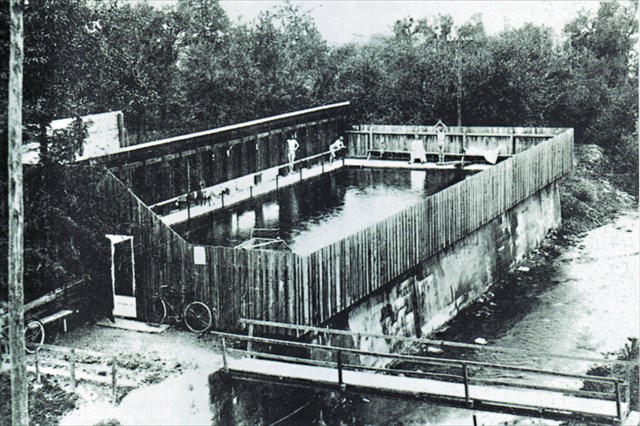

Damals:
Im Jahr 1908 - also vor über 100 Jahren - wurde das erste Wörgler Schwimmbad vom Verschönerungsverein an der Wildschönauerstraße am Wörgler Bach vor der Mühltalklamm errichtet. Eine kleine Brücke führte hier über den Bach zum Bad. In erster Linie sollte Wörgl damit für den Fremdenverkehr attraktiver werden! Das Bad wurde allerdings von der Bevölkerung und den Gästen nie so wirklich angenommen.
Lange Zeit waren deutlich zu sehen, dass die Grundmauern des später dort errichteten Hauses die Mauern des ehemaligen Bades waren. Heute ist dort nur mehr eine steile Uferverbauung.
In 1908 the first public swimming pool of Wörgl was built aside oft he Wildschönauerstraße at the stream of Wörgl („Wörgler Bach“). To reach the pool you had to cross a small bridge across the stream. Unfortunatly the people never liked the old swimming pool at the Wildschönauerstraße.
The walls of the old swimming pool could be seen a long time as the foundations of a house construated on top of the pool. Nowadays there is only a new riverbank construction left instead of the old foundation wall.
Infos zum Cache/ Cacheinformation:
Um diesen Cache zu finden müsst ihr folgende Informationen sammeln, manches davon Zuhause, manches aber auch vor Ort:
An den Wegpunkten findet ihr Informationen, die ihr für den Bonus benötigt.
1. Welche Hausnummer hat das Kraftwerk Müllnertal? = A
2. Auf der Tafel beim Kraftwerk seht ihr einen Stadplan. Auf dem Stadtplan steht am linken Rand ein Wort in einem roten Kästchen (es ist das kleinste rote Kästchen auf dem Plan!). Wieviele Buchstaben hat das Wort? Anzahl der Buchstaben = B
3. Wann wurde die Müllnertalbrücke erbaut? = C
4. Wann wurde das erste Schwimmbad in Wörgl gebaut?= D
5. Wann wurde das Kraftwerk Müllnertal in Betrieb genommen? = E
Finale Koordinaten:
N 47° 28.(C+E):2-1145-B
E 012° 04.(D:A)*10-5
To find this cache you have to collect several informations, some of them at home, some at the head coordinates:
You'll find some information at the waypoints which you need for the bonus cache.
1. Which housenumber does the power station have? = A
2. There is a map on the plaque outside the power station. If you look at the map, you can see a small red square with a word in it in the left corner towards the bottom. (It's the smallest red square on the map!) How many letters do this word have? = B
3. When was the bridge (Müllnertalbrücke) construated? = C
4. When was the first swimming pool of Wörgl built? = D
5. When was the power station at the Müllnertal put into operation? = E
Final Coordinats:
N 47° 28.(C+E):2-1145-B
E 012° 04.(D:A)*10-5